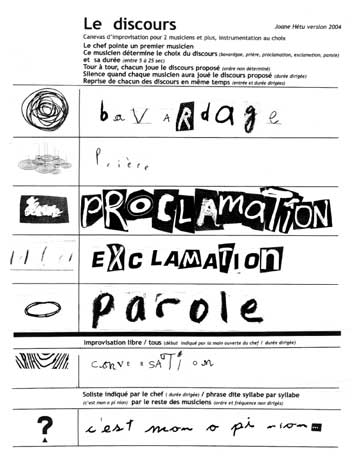
Joane Hétu
Le discours
Listen to Le discours. Written by Joane Hétu. Produced by SuperMusique. Concert recorded by Radio-Canada for the program Le Navire "Night", produced by Hélène Prévost on May 4, 2002, at Art Neuf au Centre culturel de Calixa-Lavallée, Montréal, as part of the Canevas 2002 series. Performed by Nicolas Caloia (doublebass and vocals), Aimé Dontitny (trumpet and vocals), Chantal Dumas (electronics and vocals), Lori Freedman (clarinets and vocals), Joane Hétu (vocals, saxophone, direction and vocals), Lee Pui Ming (piano and vocals), Danielle Palardy Roger (percussion and vocals).

In Le Discours (2002) Hétu explores the contrast between individual and collective discourses. Incorporating both musical and verbal conversations, Le Discours blurs the boundaries between the musical and the socio-political interactions of an improvising ensemble.
First Section
The first section includes five discursive types to choose from: “bavardage” (“babbling”), “prière” (“prayer”), “proclamation,” “exclamation,” and “parole” (“plain speech”), that might be played either solo or collectively, as designated by the leader. Each discursive type is accompanied by a graphic representation correlating to its tone. The score divides the piece into two parts. Part one focuses on individual discourse, where a designated leader in the ensemble improvises a political opinion stated verbally (in the case of “parole”/“plain speech”) or musically given any of the other discursive types. Each player then proceeds in no particular order to repeat the same statement using his or her instrument and/or voice. The original statement must therefore be brief (5-25 seconds) yet substantial enough to be both recognized and carried through multiple repetitions. Afterward, while the collective discourse takes place, each musician’s statement from part one is repeated by everyone simultaneously, while its length is directed by the leader. However, the leader might designate a collective discourse without preceding it by a succession of short solos.
Second Section
The second section is made up of an improvising conversation, either solo, duo or trio, as designated by the leader, while the other musicians each vocalise a syllable from the sentence: “C’est mon opinion” (“This is my opinion”). These two parts alternate as decided by the leader. The impact of the piece lies in the direct contrast between the individual and the unified collective statement.
Socio-political Aspect
While the musical concept is a relatively simple one, the socio-political aspect has proven to be quite challenging. Hétu points out that the emphasis is on the contrast in the delivery of a given opinion in terms of the individual versus the collective, whether one agrees with it or not. Hétu has found that many players have difficulty with this notion. Therefore, in contrast to 12 Moments brefs, Le Discours requires a lot of rehearsal.
 English |
English |